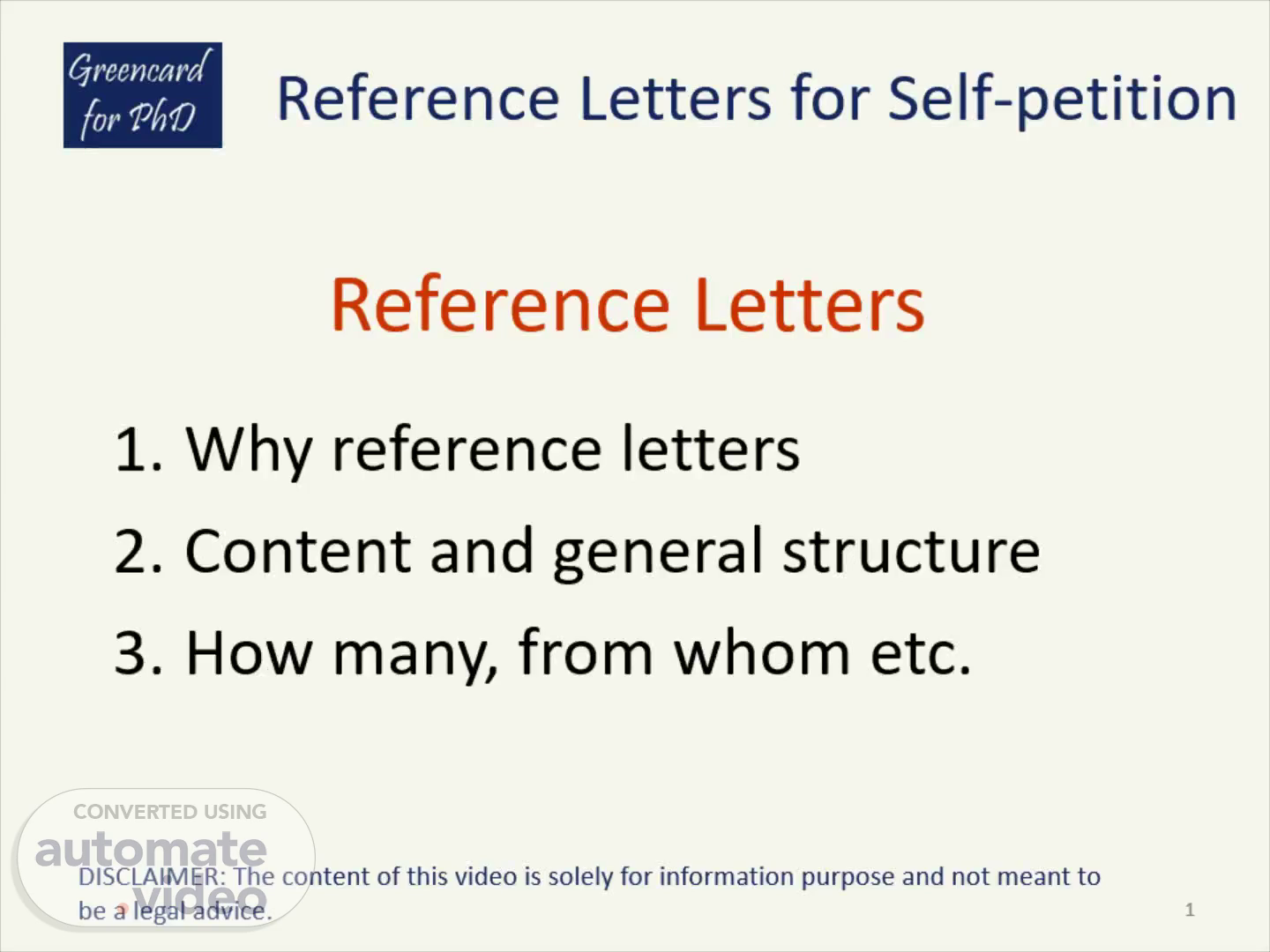
Page 1 (0s)
[Audio] Welcome to Green Card for PhD. Before we begin a quick disclaimer: The content of this presentation is solely for information purpose and not meant to be a legal advice. With the disclaimer out of the way, let start the topic of the video. In this video we will discuss some details of reference letters in green card application process. If you have not seen our other videos on what a self-petition is and different categories, we suggest you watch those videos before watching this. If you are interested in a DIY solution, we suggest you visit our website. In this video we will discuss the main constituents of a reference letter, structure, content and along with answering questions such as how many letters and from whom to obtain. We mainly discuss or answer these primarily in the context of a self-petition or the EB1A or NIW categories..
Page 2 (59s)
[Audio] Reference letters are letters that you obtain in support of your self-petition application process. So, in general, the main goal of the letters is to support and substantiate your claims in the petition letter. As you are probably aware the two self-petition categories have their own set of criteria outlined by USCIS. Despite the difference in the criteria the general approach to how the reference letters are prepared is very similar. While EB1A and NIW letters are similar, they differ in the content and how the letters are worded to explain your achievements that meet the USCIS requirements. We will not go into details on the differences between various categories but mention the commonalities here..
Page 3 (1m 47s)
[Audio] Broadly speaking there are two types of letters. Letters from collaborators and independent reviewers. You should try to obtain some letters from researchers who have collaborated with you and some from those who are aware of your work or have used your work as part of their research but have not worked with you on a project. We are commonly asked as to what type of referees should you choose for the letters. You should choose referees who are widely known and/or very well accomplished in their work. Credentials of referees such as number of publications, citations, awards, committees chaired, total research or grants awarded add to the weight of their reference. Career position(s) held by the referee such as researcher at national lab, endowed chair/professor etc will convey that you have support of top researchers in your field. What is a good number of reference letters to obtain? We generally recommend 6 to 10 letters with 1 to 3 independent references. More letters are not necessarily useful. Content of the letter ( specifics of why you qualify) and the credentials of the referee are more important than the number. What should be the content of the letters? The letters should focus on concrete examples with details such as importance of your work, how it is being used, what your specific contributions to the collaborative research are, what impact your work has made or expected to make etc. A fairly detailed examples (two to four paragraphs) with a total reference letter length of 1.5 to 2.5 pages would be beneficial. What is the structure of a typical letter? A typical letter is structured as follows. Opening paragraph is used to tell the examiner that the referee plans to provide support for your EB1A or NIW application. Following this the referee would introduce himself/herself, by mentioning the referees credentials and standing in the research field or career. The referee provides details of how the referee is acquainted with you or your work, if and how he/she knows you, how long you are working/collaborating together or if the referee knows you only through your work. Rest of the letter would focus on specifics of your work and why the referee thinks you satisfy EB1a regulatory requirements and the extraordinary ability condition (you are at the top of your field and there is sustained national interest). It is very important for the letter to illustrate, with specific examples, how you meet the USCIS requirements. Depending on your circumstances, different letters can focus on one or more of the requirements. Our do-it-yourself packets contain more than 15 reference letters which were used originally in various USCIS EB1A or NIW petitions. These letters can be used as examples for preparing your I- 140 petition..
Page 4 (4m 45s)
[Audio] If you are just learning about the I140 application process, then you probably have several other questions. What criteria do I need to satisfy to apply? What category do I choose EB1A or NIW? What is the exact process I need to follow to apply for one of these applications? We'll answer these questions and many others in our rest of the videos. Please remember to like this video, subscribe, and watch our other videos. Green card for PhD is a small team of professionals who have obtained their green cards via the process detailed in our videos and the DIY packets. Our DIY packets contain examples of successful applicants. Please visit our website to know more about the DIY packets..